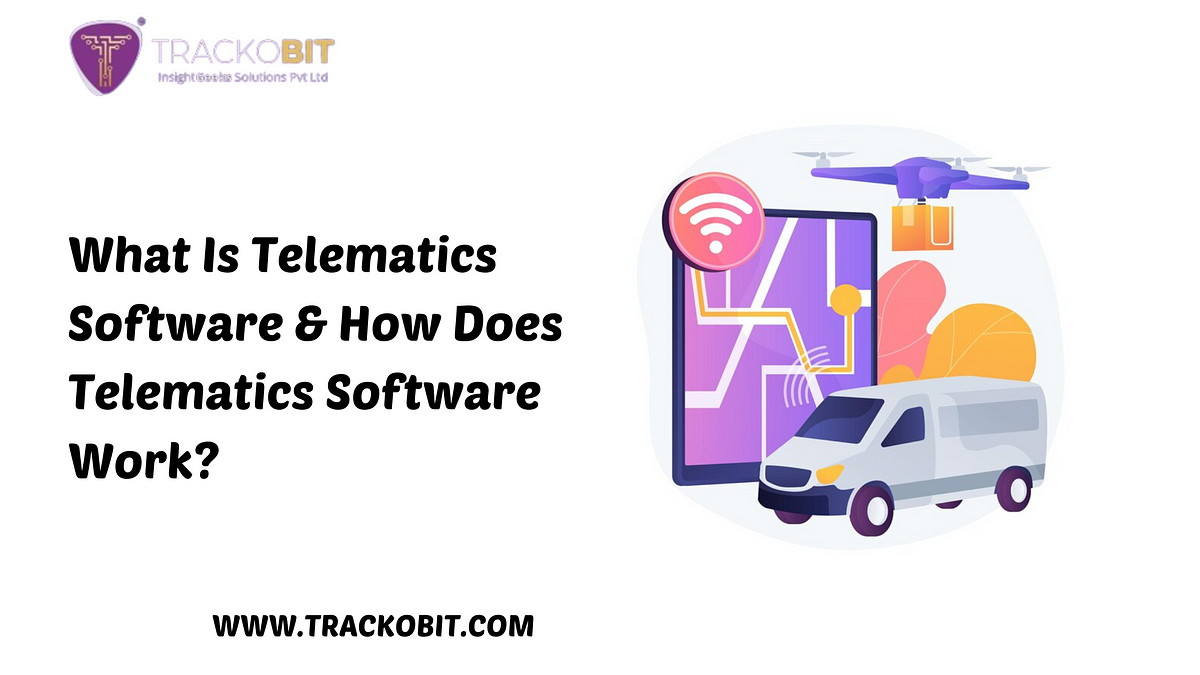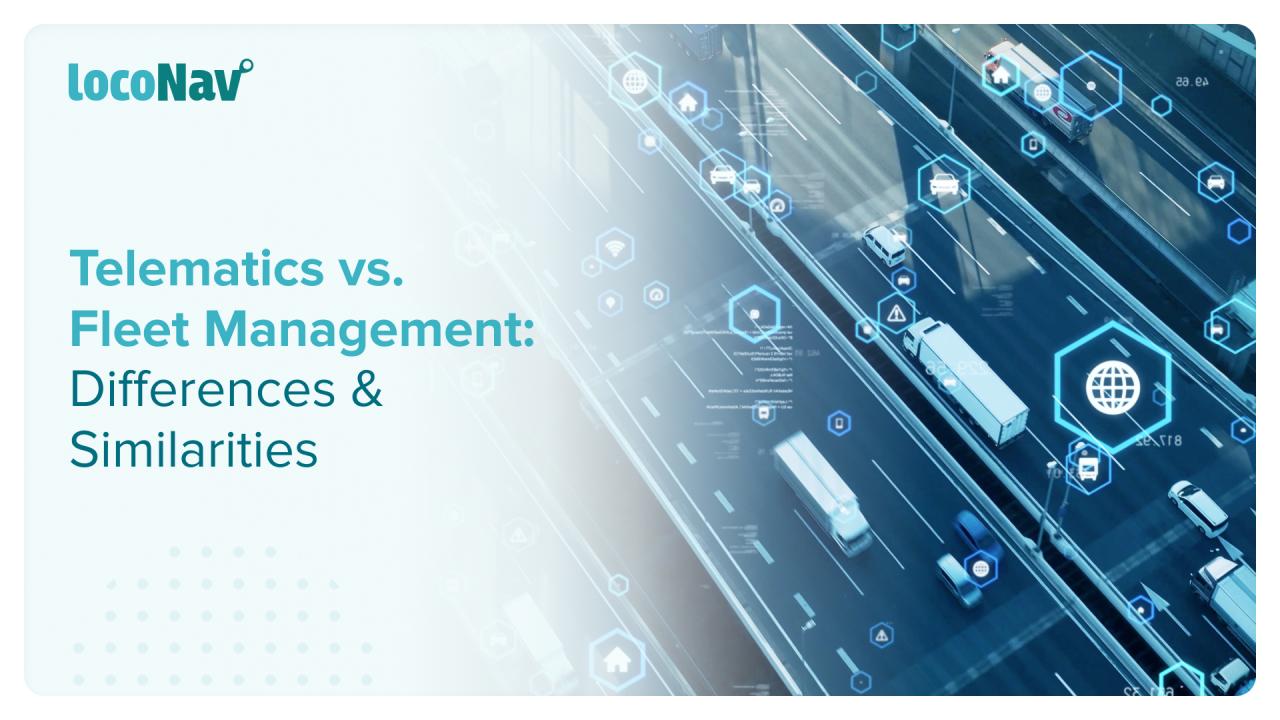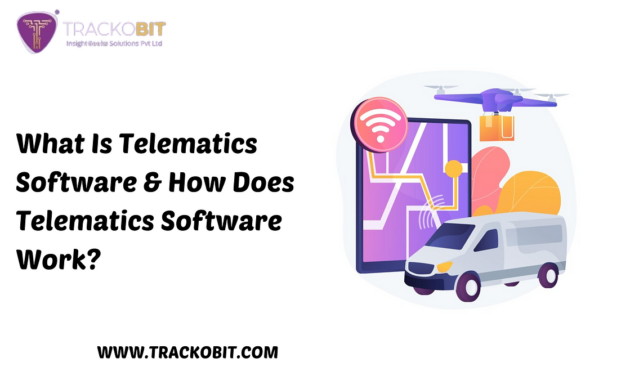Fleet telematics tracking is revolutionizing the way transportation operates, providing real-time insights that enhance efficiency and safety. With the integration of advanced technologies such as GPS and IoT devices, fleet managers can monitor their vehicles’ locations, performance, and driver behaviors like never before. This not only leads to significant cost savings but also improves compliance and enhances the overall safety of operations across various industries.
As more businesses recognize the value of fleet telematics tracking, it’s becoming clear that this system is crucial for optimizing logistics, reducing carbon footprints, and staying competitive in a rapidly evolving market. From delivery services to construction firms, the application of telematics is broad, impacting how companies make decisions and manage their resources.
Introduction to Fleet Telematics Tracking
Fleet telematics tracking is a technology that integrates telecommunications and monitoring systems to provide real-time data on vehicles within a fleet. This system is pivotal in enhancing operational efficiency, safety, and the overall management of transportation processes. By leveraging GPS technology and onboard diagnostics, fleet telematics allows businesses to optimize route planning, monitor vehicle performance, and track driver behavior, all of which contribute significantly to reducing costs and improving service quality.Several components form the backbone of telematics systems, making them effective for fleet management.
Key elements include GPS receivers that determine the precise location of vehicles, onboard diagnostic systems that provide critical vehicle health data, and communication interfaces that relay data between vehicles and central management systems. These components work together seamlessly to deliver valuable insights for fleet operators. Additionally, software platforms aggregate and analyze this data, offering dashboards and reporting functionalities that help in decision-making.
Main Industries Benefiting from Fleet Telematics
Fleet telematics tracking solutions are advantageous across various industries, each utilizing the technology to address specific operational challenges. The following sectors particularly benefit from implementing telematics systems:
- Transportation and Logistics: Companies in this sector use telematics to improve route efficiency, reduce fuel consumption, and enhance delivery accuracy.
- Construction: Construction firms leverage telematics to track heavy machinery and equipment usage, ensuring compliance with safety regulations and maximizing uptime.
- Public Transport: Fleet management systems enable public transport authorities to monitor bus and train schedules, enhancing passenger experience through reliable services.
- Food and Beverage: Businesses in this industry rely on telematics to track temperature-sensitive deliveries, ensuring product quality from storage to delivery.
- Service and Maintenance: Companies providing field services utilize telematics for efficient scheduling and real-time updates, improving customer satisfaction and operational efficiency.
Telematics tracking systems also provide essential data that contributes to regulatory compliance, enhances safety protocols, and fosters sustainable practices by reducing carbon footprints. The significance of these systems cannot be overstated, as they empower industries to operate more effectively in a competitive landscape.
Benefits of Fleet Telematics Tracking
Fleet telematics tracking offers a multitude of advantages that go beyond mere vehicle location. By integrating advanced technology into fleet management, businesses can achieve significant improvements in operational efficiency, safety, compliance, and environmental sustainability. These benefits collectively enhance the overall performance and cost-effectiveness of fleet operations.
Cost Savings from Efficient Fleet Management
Efficient fleet management through telematics can lead to substantial cost savings for businesses. By utilizing real-time data analytics, companies can optimize fuel usage, reduce maintenance costs, and improve labor efficiency. Consider the following aspects that contribute to savings:
- Fuel Efficiency: With telematics systems monitoring vehicle performance and driving behaviors, fleets can identify inefficient practices such as excessive idling or rapid acceleration. Studies show that implementing fuel management strategies can reduce fuel costs by up to 20%.
- Maintenance Optimization: Predictive maintenance alerts help prevent unexpected breakdowns, allowing for scheduled repairs that minimize vehicle downtime. This proactive approach can lower maintenance costs by as much as 30%.
- Insurance Discounts: Many insurance companies offer lower premiums for fleets utilizing telematics due to enhanced safety measures and reduced risk of accidents. Businesses can save significantly on insurance costs.
Enhanced Driver Safety and Compliance
Telematics systems play a crucial role in promoting driver safety and ensuring compliance with regulations. The ability to track driving habits and vehicle conditions not only helps in managing risk but also fosters a culture of safety within the organization. Key benefits include:
- Real-Time Monitoring: Continuous tracking of driver behavior allows managers to identify risky driving patterns such as speeding or harsh braking, enabling timely interventions to enhance safety.
- Training and Accountability: Data-driven insights can inform tailored training programs for drivers, focusing on areas needing improvement. This accountability encourages safer driving practices.
- Regulatory Compliance: Telematics helps ensure compliance with driving hours regulations and vehicle maintenance standards, reducing the risk of legal issues and penalties.
Environmental Benefits Linked to Optimized Route Planning, Fleet telematics tracking
Fleet telematics significantly contributes to environmental sustainability by optimizing route planning and reducing carbon footprints. This not only benefits the planet but can also enhance a company’s public image. Critical benefits include:
- Route Optimization: Telematics systems analyze traffic patterns and road conditions in real-time, allowing drivers to select the most efficient routes. This can lead to a reduction in travel distances by 10-15%, translating into lower fuel consumption.
- Reduced Emissions: By minimizing fuel usage, optimized routing directly contributes to lower greenhouse gas emissions. Companies can demonstrate their commitment to sustainability, appealing to eco-conscious customers.
- Idle Time Reduction: Telematics can significantly decrease idle times through real-time tracking and alerts for excessive idling. Reducing idle time can improve fuel efficiency and reduce pollution.
Technology Behind Fleet Telematics Tracking
Fleet telematics tracking integrates various advanced technologies to provide real-time data and insights into vehicle performance and logistics management. By leveraging these technologies, fleet operators can enhance operational efficiency, optimize routes, and improve overall fleet management practices.Key technologies that form the backbone of fleet telematics include GPS and IoT devices. GPS (Global Positioning System) technology allows for precise location tracking of vehicles, providing fleet managers with real-time positional data.
IoT (Internet of Things) devices enable vehicles to communicate with centralized systems, gathering information on various metrics like fuel consumption, engine health, driver behavior, and more. This technology ensures that all necessary data points are captured for analysis and decision-making.
Role of Data Analytics in Fleet Operations
Data analytics plays a critical role in improving fleet operations by transforming raw data collected from vehicles into actionable insights. Analyzing data helps fleet managers identify patterns and trends that can lead to better decision-making and operational improvements. The importance of data analytics in fleet telematics is underscored by its ability to enhance performance metrics. By analyzing driver behavior, companies can pinpoint areas for improvement, such as harsh braking or excessive idling, which could lead to increased fuel costs and safety risks.
Additionally, predictive analytics can be utilized to forecast maintenance needs before issues arise, thus reducing downtime and repair costs.Examples of software platforms that integrate telematics data include:
- Geotab: This platform provides comprehensive fleet management features, including vehicle tracking, driver performance monitoring, and customizable reporting tools.
- Fleet Complete: An all-in-one solution that offers telematics, asset tracking, and mobile workforce management, helping businesses streamline their operations.
- Teletrac Navman: Known for its user-friendly interface, this software provides real-time tracking, compliance management, and detailed analytics on fleet performance.
“Data-driven decisions in fleet management can lead to significant cost reductions and improved safety metrics.”
By applying these technologies and utilizing data analytics, fleet operators can ensure their vehicles are not only tracked efficiently but also managed in a way that maximizes performance and minimizes costs.
Implementation of Fleet Telematics Systems

Implementing a fleet telematics system is a strategic move that can significantly enhance operational efficiency and fleet management. A well-structured approach ensures that the transition is smooth and aligns with the company’s objectives. The process involves several steps, each crucial for maximizing the benefits of telematics technology.The successful implementation of a telematics solution in a fleet requires meticulous planning and execution.
Key steps typically include assessing fleet needs, selecting the right technology, integrating the system with existing processes, training staff, and continuously evaluating performance. Each step is essential to ensure that the telematics system meets the specific needs of the fleet and delivers optimal results.
Steps Required to Implement a Telematics Solution
To implement a telematics solution effectively, organizations must follow a structured process. It typically includes the following key steps:
1. Assess Fleet Needs
Identify specific objectives for using telematics, such as tracking vehicle performance, reducing fuel costs, or improving driver safety.
2. Research and Choose a Provider
Explore various telematics providers to find one that offers the features that align with your needs and budget.
3. Pilot Testing
Conduct a pilot test with a small segment of your fleet to evaluate the system’s performance and gather feedback from users.
4. Full-Scale Implementation
Once the pilot is successful, roll out the system across the entire fleet, ensuring all vehicles are equipped with the necessary hardware.
5. Staff Training
Provide comprehensive training for your team on how to use the telematics system effectively, focusing on both technical and operational aspects.
6. Ongoing Evaluation
Regularly assess the system’s performance and make adjustments as necessary to optimize its use and address any emerging challenges.
Key Considerations for Choosing the Right Telematics Provider
Choosing the right telematics provider is a critical aspect of successful implementation. Several factors should be taken into account to ensure that the selected partner can effectively meet the fleet’s requirements:
Reputation and Experience
Look for providers with a proven track record and positive customer reviews in the telematics industry.
Feature Set
Ensure that the provider offers essential features such as real-time tracking, route optimization, and maintenance alerts.
Scalability
Choose a system that can grow with your fleet and adapt to changing business needs.
Integration Capabilities
The ability to integrate with existing systems such as ERP or fleet management software can enhance operational efficiency.
Customer Support
Evaluate the level of customer service and technical support offered, ensuring that help is readily available when needed.
Checklist of Essential Features for an Effective Telematics System
An effective telematics system should encompass a range of essential features that contribute to optimal fleet management. Here’s a checklist to guide the selection process:
Real-time GPS Tracking
Provides instant visibility into vehicle locations, enhancing route management and security.
Driver Behavior Monitoring
Tracks metrics such as speed, braking, and acceleration to promote safer driving habits.
Fuel Consumption Reports
Offers insights into fuel usage patterns, helping to identify areas for cost reduction.
Maintenance Alerts
Sends notifications for scheduled maintenance, preventing breakdowns and prolonging vehicle lifespan.
Geofencing Capabilities
Allows users to set virtual boundaries and receive alerts when vehicles enter or exit designated areas.
Data Analytics and Reporting
Provides comprehensive reports that facilitate data-driven decision-making and operational improvements.The integration of these features into a telematics system not only enhances fleet visibility but also drives efficiency and cost savings.
Case Studies of Successful Fleet Telematics Tracking
Many companies have successfully leveraged fleet telematics tracking to enhance their operations, reduce costs, and improve safety. By integrating telematics systems into their fleets, businesses have been able to monitor vehicle performance, optimize routes, and improve driver behavior. Here are some notable examples of companies that have successfully implemented telematics solutions and the metrics they utilized to measure their success.
Examples of Successful Implementation
Several companies across various industries have adopted fleet telematics solutions, resulting in significant operational improvements. Notable examples include:
- UPS: UPS has employed telematics to optimize their delivery routes, leading to an estimated reduction of 10 million gallons of fuel consumption annually. They measure success through metrics such as fuel efficiency, delivery times, and overall operational cost savings.
- FedEx: FedEx utilizes telematics to monitor driver behavior and vehicle maintenance. Their success is measured by tracking metrics like accident rates, maintenance costs, and on-time delivery performance, resulting in an improved overall safety rating.
- Waste Management: By implementing telematics, Waste Management improved route efficiency, which contributed to a 10% reduction in fuel costs. They focus on metrics such as route optimization and vehicle utilization to gauge success.
Metrics for Measuring Success in Fleet Telematics
Measuring the success of fleet telematics involves analyzing various key performance indicators (KPIs) that reflect operational efficiency and cost-effectiveness. Key metrics include:
- Fuel Consumption: Monitoring fuel usage enables companies to identify trends and areas for improvement, leading to substantial cost savings.
- Driver Behavior: Metrics such as speeding incidents, harsh braking, and idling time provide insights into driver performance and safety, empowering companies to implement training programs.
- Maintenance Costs: Keeping track of vehicle maintenance and repair expenses helps in budgeting and extends the lifespan of the fleet.
- Route Efficiency: Analyzing routing data allows companies to reduce travel distances and times, improving delivery efficacy.
Comparison of Telematics Solutions Across Different Sectors
Fleet telematics solutions vary according to industry requirements, with businesses adopting tailored technologies that best suit their operations. A comparison of telematics solutions in different sectors illustrates this diversity:
| Industry | Telematics Solution | Key Features |
|---|---|---|
| Transportation | GPS Tracking Systems | Real-time location tracking, route optimization, driver performance metrics |
| Construction | Equipment Telemetry | Asset tracking, maintenance alerts, utilization monitoring |
| Delivery Services | Mobile Telematics Apps | Driver behavior monitoring, delivery scheduling, customer notifications |
| Public Services | Fleet Management Software | Vehicle tracking, work order management, fuel consumption analysis |
“The implementation of telematics systems has transformed fleet operations from reactive to proactive management.”
Future Trends in Fleet Telematics

The landscape of fleet telematics is continuously evolving, driven by advancements in technology and changing demands within the industry. As we look toward the future, several emerging technologies and trends are set to shape how businesses track and manage their fleets. Understanding these trends is crucial for organizations looking to remain competitive and efficient in their operations.One of the most significant emerging technologies influencing fleet telematics is the integration of artificial intelligence (AI) and machine learning.
These technologies enhance data analysis capabilities, enabling predictive maintenance and optimized route planning. By analyzing historical data and real-time inputs, AI can predict potential vehicle issues before they become critical, thus minimizing downtime and repair costs. Additionally, smart algorithms can suggest the most efficient routes based on traffic patterns and weather conditions, resulting in fuel savings and improved delivery times.
Challenges in Adopting Telematics Systems
The adoption of fleet telematics systems comes with its own set of challenges that organizations must navigate. Recognizing these hurdles is essential for successful implementation and operation.
- Infrastructure Costs: Implementing a telematics system involves initial infrastructure investments, including hardware, software, and training for personnel.
- Data Integration: Integrating telematics data with existing fleet management systems can be complex and requires careful planning to avoid data silos.
- Technology Adoption Resistance: Employees may resist new technologies due to fear of change or lack of familiarity, necessitating effective change management strategies.
- Dependence on Connectivity: Telematics systems often rely on stable internet connections, which can pose issues in remote areas with limited access.
Opportunities in Fleet Telematics
Despite the challenges, there are numerous opportunities that come with the implementation of telematics systems. Businesses can leverage these advantages to enhance their operations and increase profitability.
- Improved Safety: Real-time monitoring of driver behavior can lead to safer driving practices, reducing accident rates and associated costs.
- Enhanced Customer Experience: Accurate tracking and communication can improve service delivery and customer satisfaction by providing timely updates on shipments.
- Environmental Impact: Telematics can help companies reduce their carbon footprint by optimizing routes and improving fuel efficiency.
- Data-Driven Decision Making: The vast amount of data generated allows for more informed decisions regarding fleet management and operational strategies.
Impact of Data Privacy Regulations
Data privacy regulations are becoming increasingly stringent, impacting how telematics systems collect, manage, and utilize data. Organizations must be aware of these regulations to ensure compliance and protect customer information.The General Data Protection Regulation (GDPR) in Europe and various other local laws highlight the importance of transparency in data usage. Companies need to establish clear consent protocols and ensure that the data collected is stored securely and used responsibly.
Non-compliance can result in significant fines and damage to reputation.In addition, organizations should adopt advanced encryption methods and anonymization techniques to protect sensitive information. As customer awareness of data privacy grows, demonstrating a commitment to protecting personal data can enhance brand trust and customer loyalty.
Best Practices for Using Fleet Telematics Tracking
Incorporating fleet telematics tracking into daily operations is a multifaceted endeavor that requires careful planning and execution. To maximize the benefits of telematics, it is essential to adopt best practices that ensure data is effectively utilized and integrated into the overall fleet management strategy. This section Artikels key practices that can enhance performance, improve staff training, and maintain the integrity of telematics systems.
Guidelines for Utilizing Telematics Data
Efficient use of telematics data can significantly enhance operational performance and decision-making. Here are some guidelines to consider:
- Set Clear Objectives: Define specific goals for what you want to achieve with telematics, such as reducing fuel consumption, improving route efficiency, or decreasing maintenance costs.
- Regular Data Review: Establish a routine to analyze telematics data. Frequent reviews can help identify trends and areas for improvement, enabling quick adjustments to fleet operations.
- Integrate with Other Systems: Link telematics data with other software systems (like fleet maintenance or HR systems) to create a holistic view of operations and facilitate better decision-making.
- Data-Driven Decision Making: Use insights from telematics data to inform strategic decisions, such as vehicle purchasing, route planning, and driver training programs.
Strategies for Training Staff on Telematics Systems
Training staff effectively on telematics systems is crucial for successful implementation and utilization. Here are some strategies to enhance training efforts:
- Hands-On Training Sessions: Conduct interactive training sessions where staff can engage with the telematics system directly, allowing them to become familiar with its features and functionalities.
- Utilize Real-World Scenarios: Incorporate case studies or real-world examples during training to demonstrate the practical applications of telematics data in daily operations.
- Provide Continuous Education: Offer ongoing training workshops and resources that keep staff updated on new features and best practices related to telematics systems.
- Encourage Feedback: Create an open channel for feedback on training materials and sessions to ensure they meet the needs of the staff and address any challenges they face using telematics.
Importance of Regular Maintenance and Updates for Telematics Devices
Maintaining telematics devices is critical to ensure their reliability and accuracy. Regular maintenance and timely updates can prevent operational disruptions and enhance system performance. Consider the following points:
- Schedule Routine Checks: Conduct regular inspections of telematics hardware and software to identify and rectify any issues before they escalate into major problems.
- Update Software Regularly: Ensure that telematics software is updated to the latest version to take advantage of new features, security enhancements, and bug fixes.
- Train on Device Maintenance: Educate staff on basic maintenance procedures for telematics devices to empower them to perform preliminary checks and ensure optimal functioning.
- Document Maintenance Activities: Keep detailed records of all maintenance and updates performed on telematics devices for accountability and future reference.
FAQ Compilation
What is fleet telematics tracking?
Fleet telematics tracking refers to the use of technology to monitor and manage a fleet of vehicles, providing real-time data on location, performance, and driver behavior.
How can fleet telematics tracking help reduce costs?
It helps reduce costs by optimizing routes, improving fuel efficiency, and minimizing maintenance expenses through proactive management.
What types of businesses benefit from fleet telematics?
Businesses in various sectors such as logistics, transportation, construction, and public services benefit from fleet telematics tracking solutions.
Is fleet telematics tracking compliant with data privacy regulations?
Yes, most fleet telematics systems are designed to comply with data privacy regulations, but it’s essential for businesses to choose providers that prioritize data protection.
How often should telematics systems be updated?
Telematics systems should be updated regularly to ensure optimal performance and to incorporate the latest features and security enhancements.















